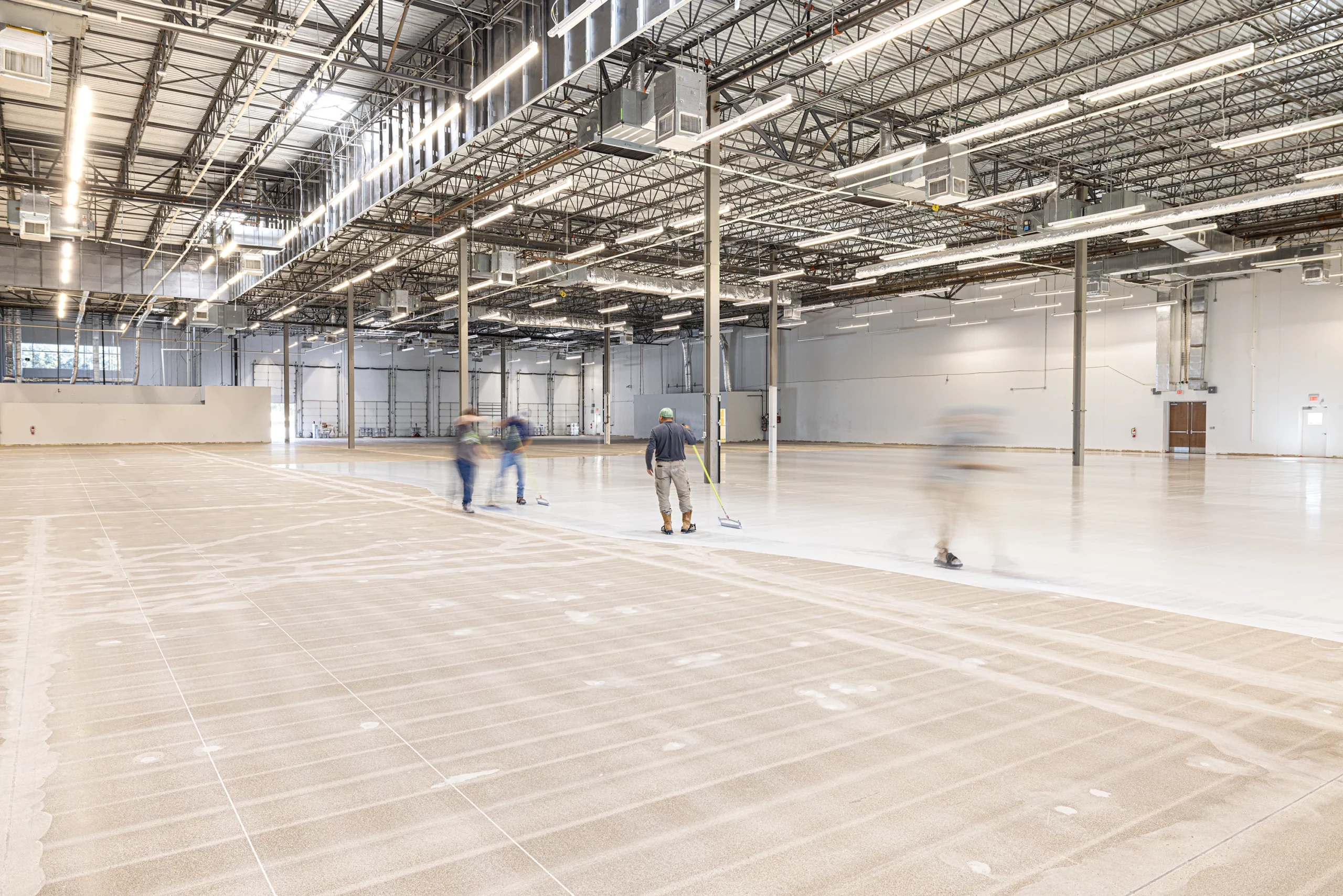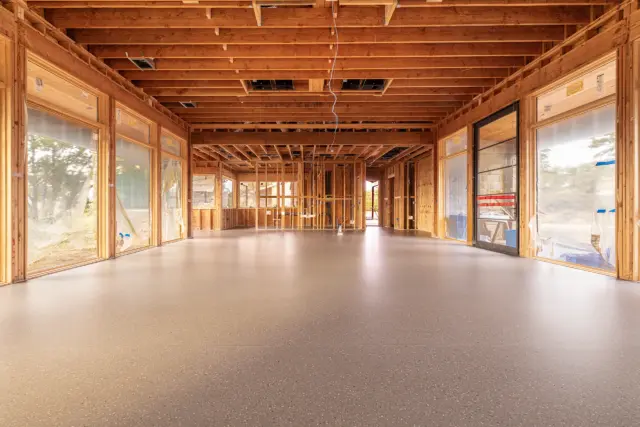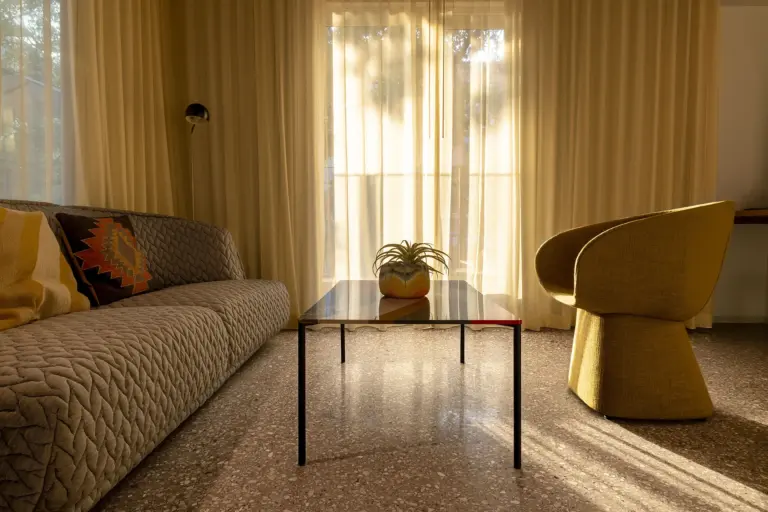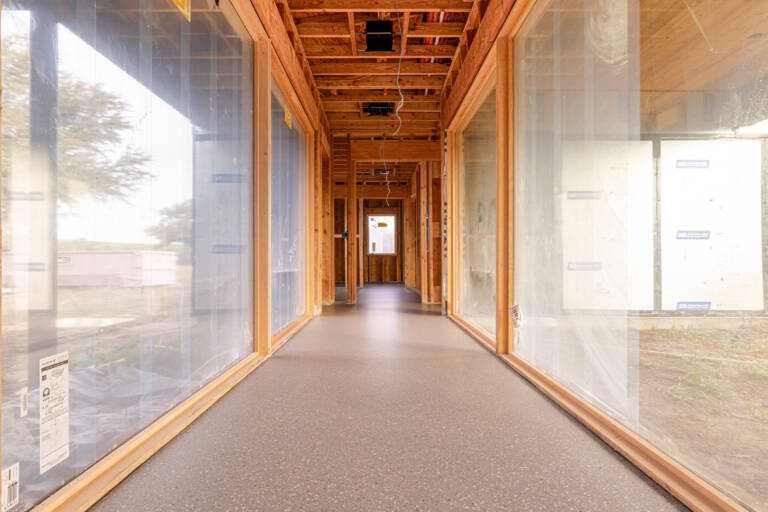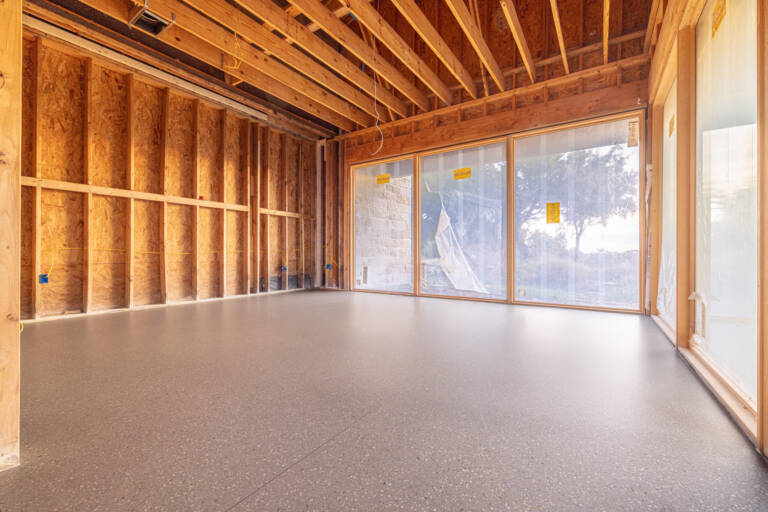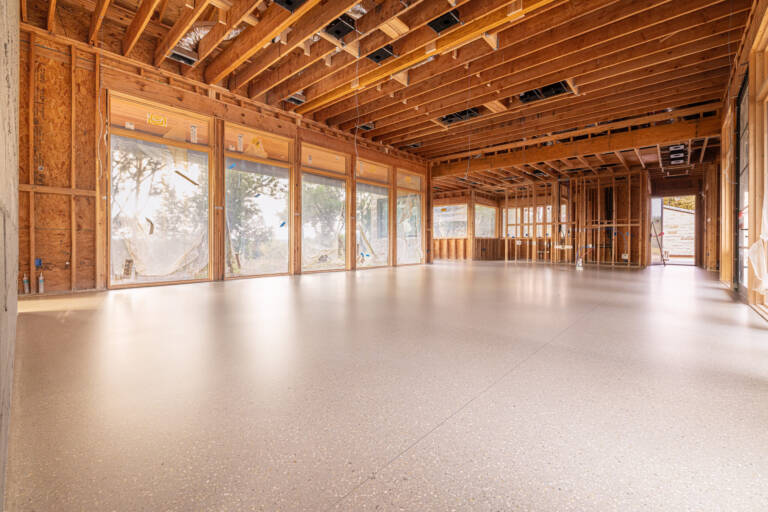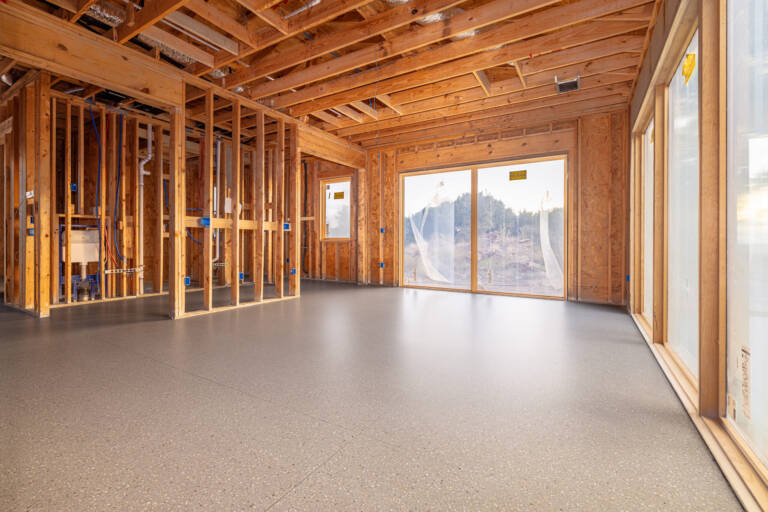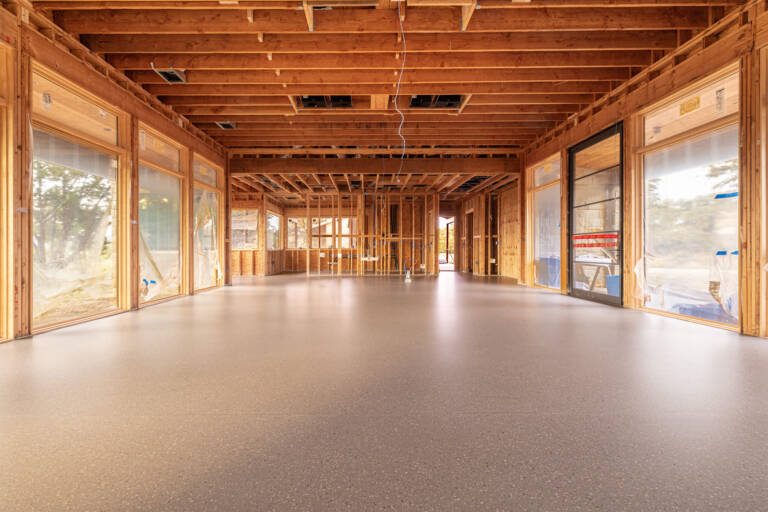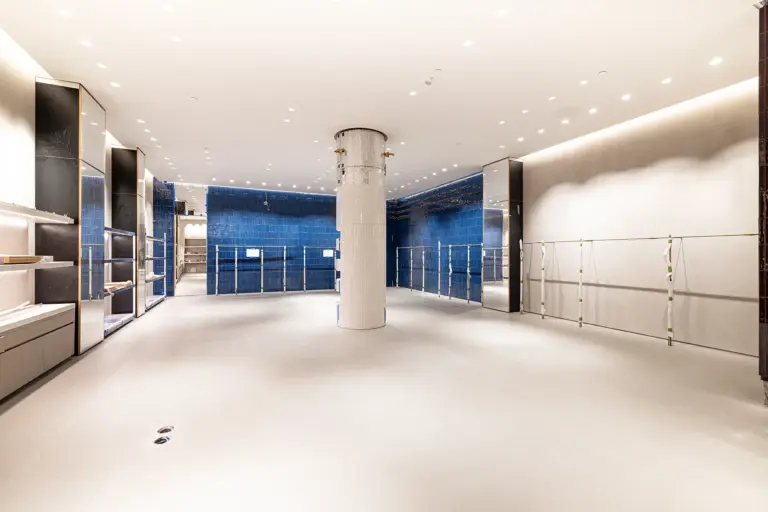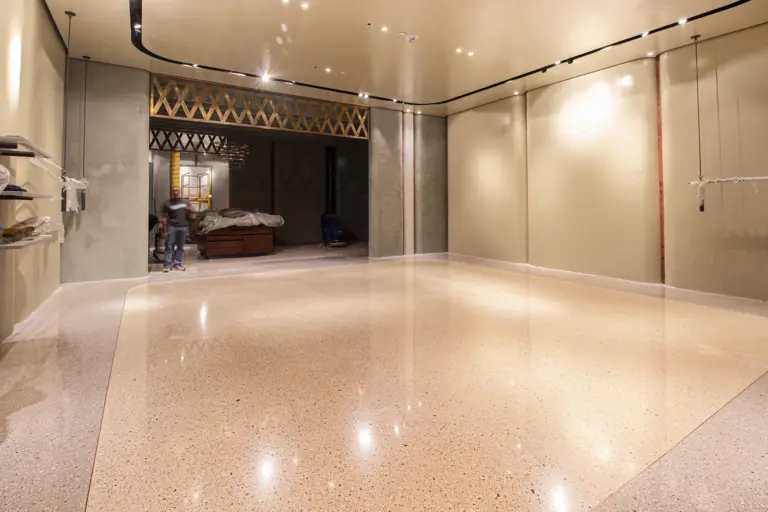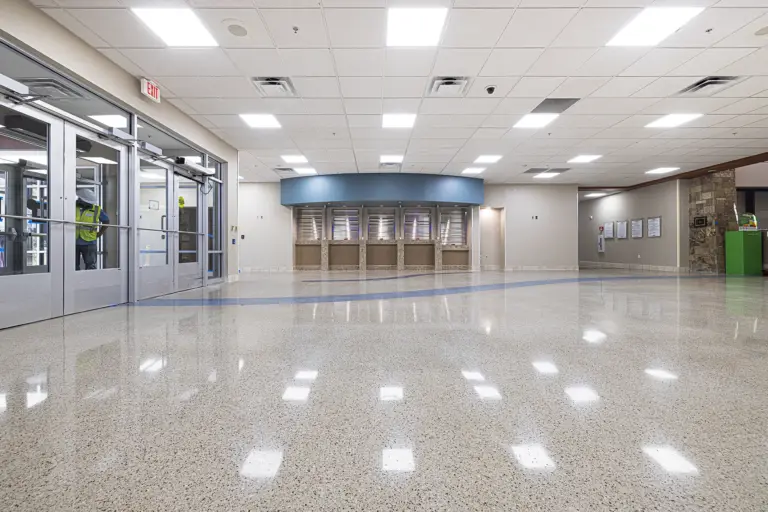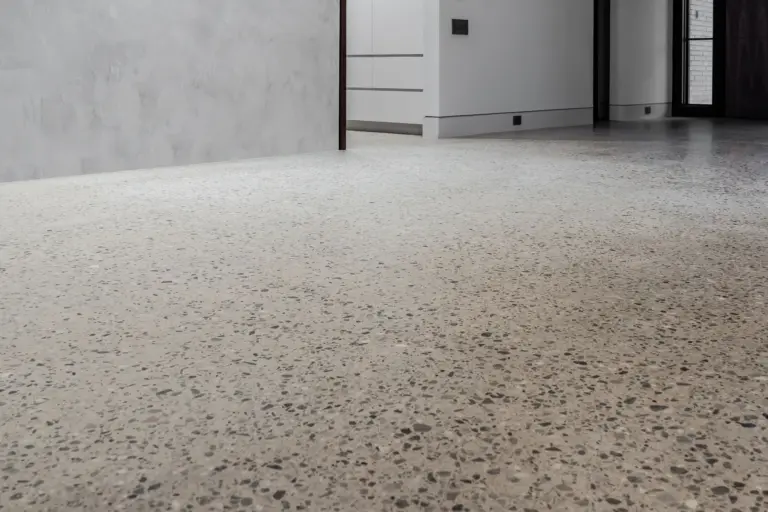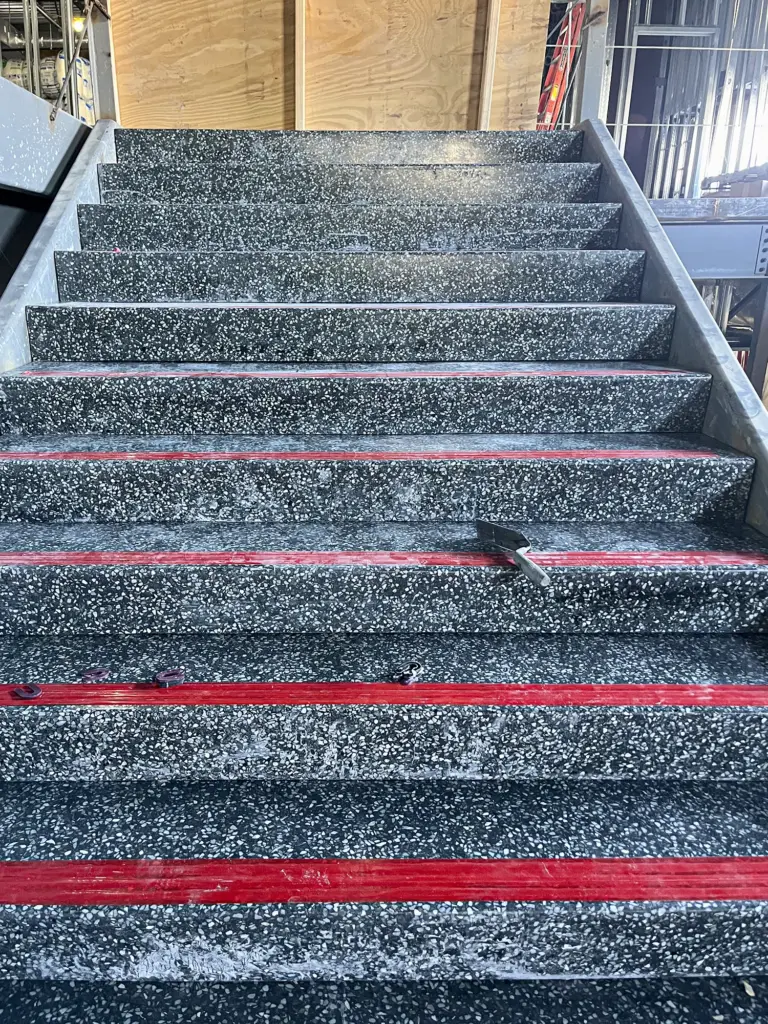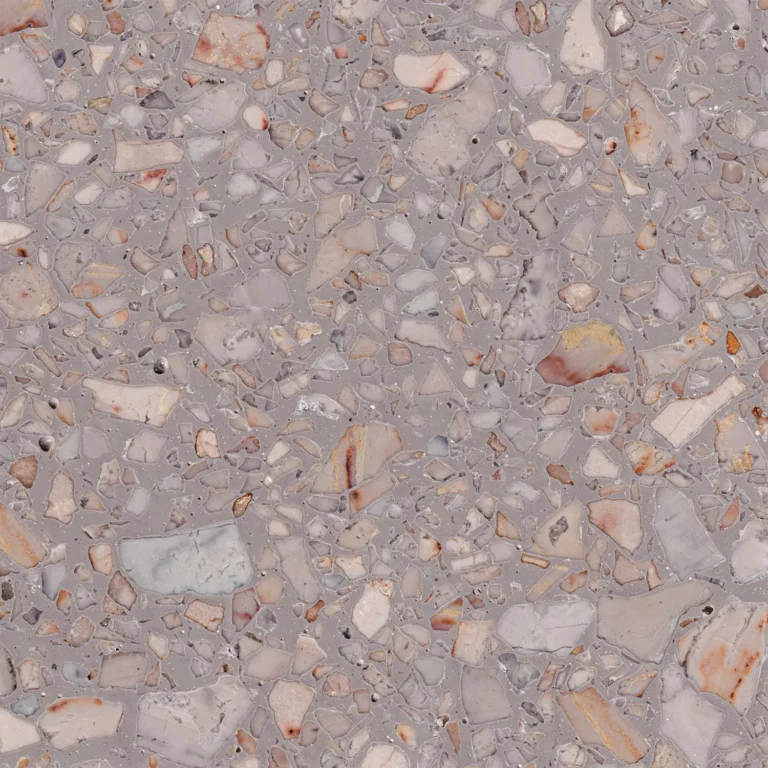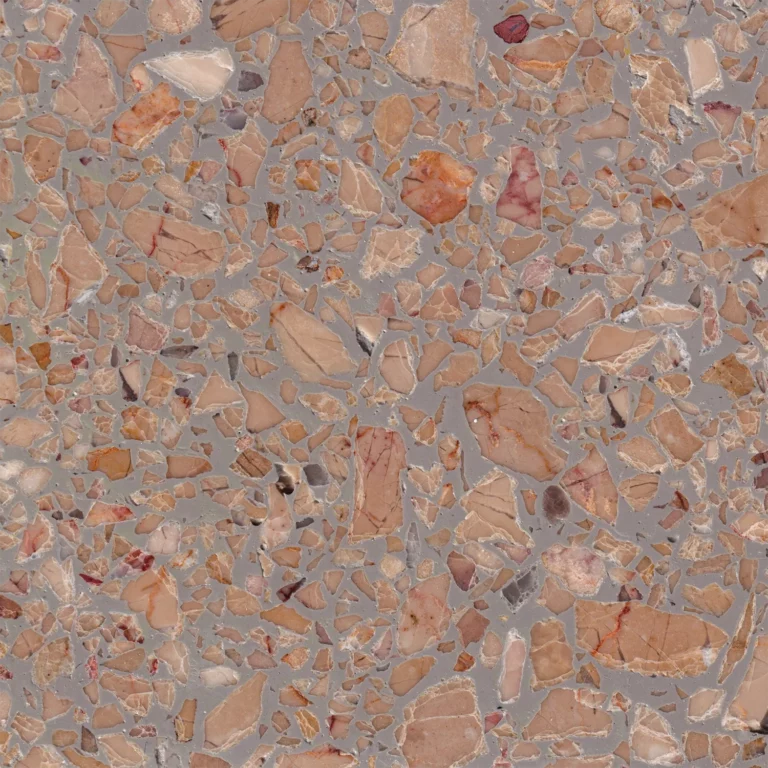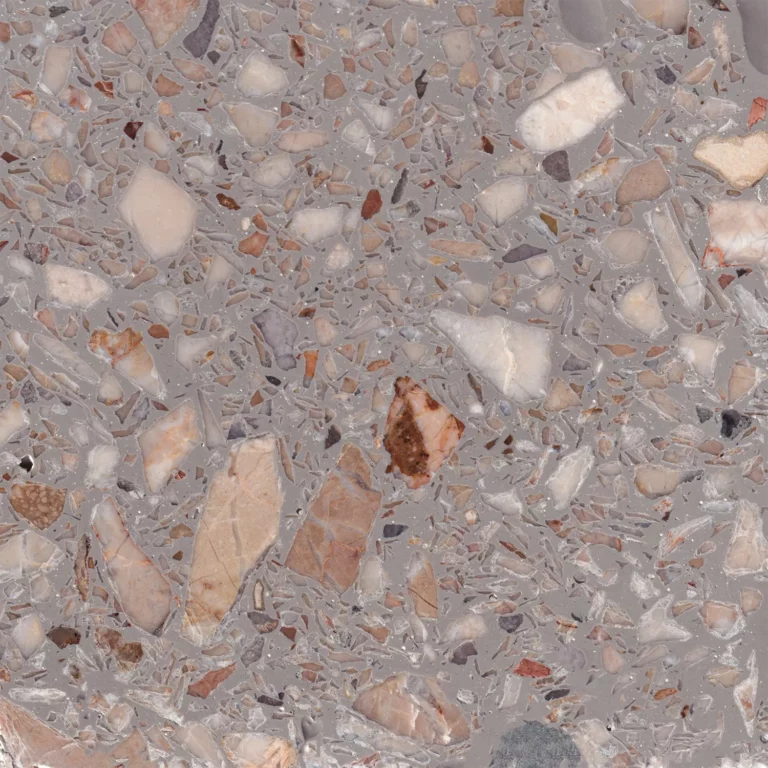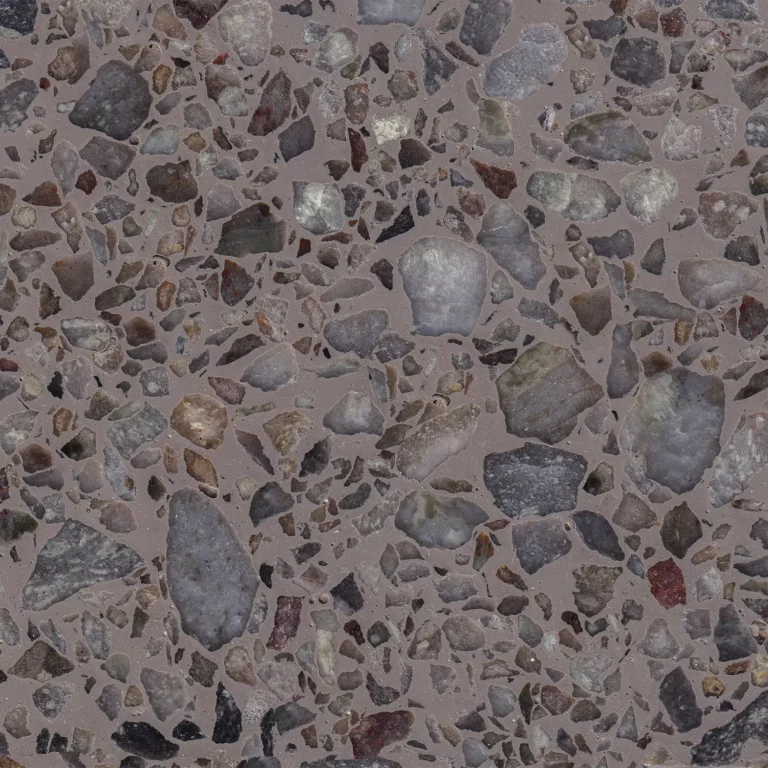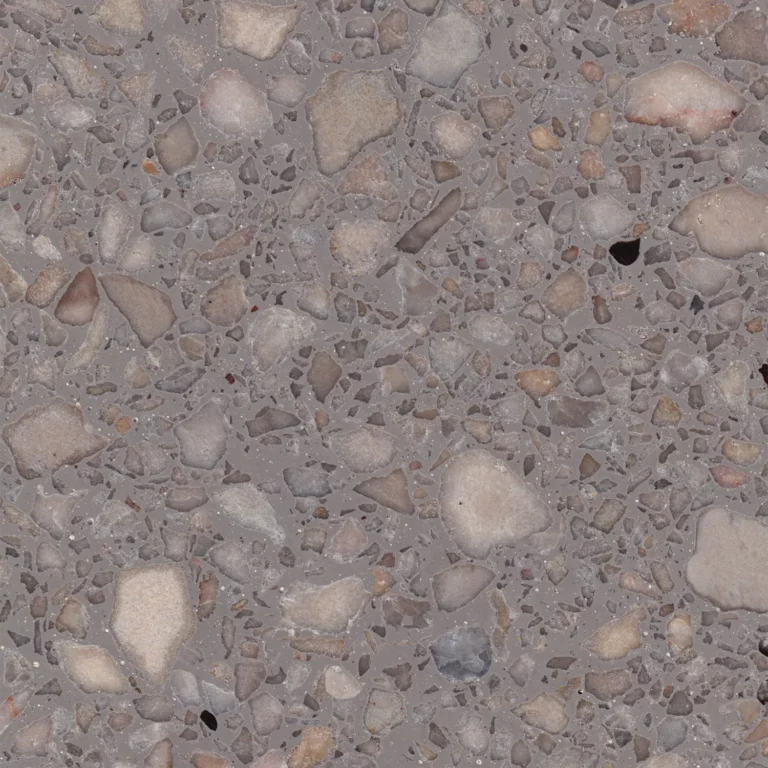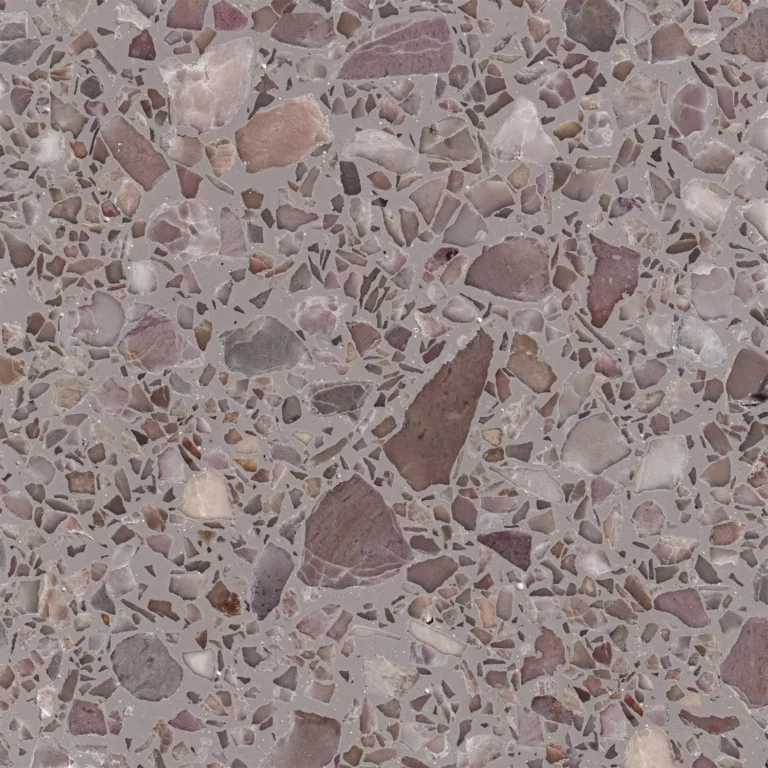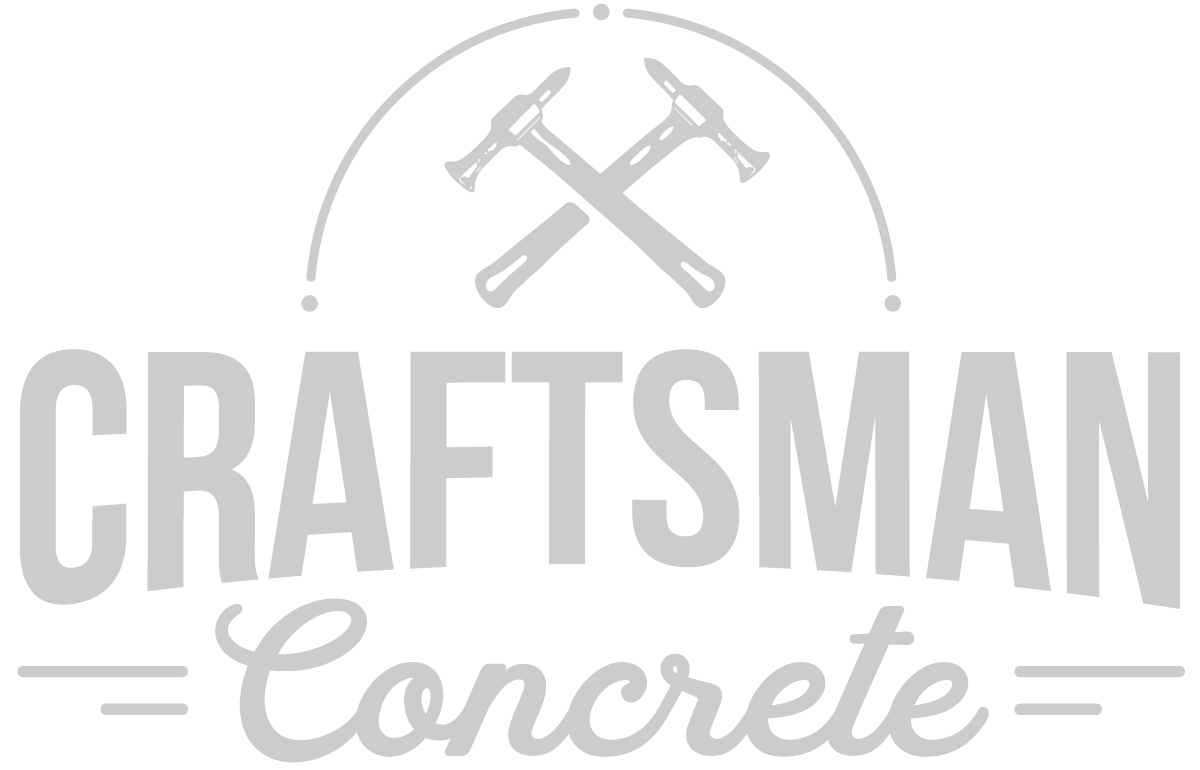Terrazzo Floor Restoration
Terrazzo flooring is one of the most resilient types of flooring available. In fact, we engineer terrazzo floors to outlast the buildings they’re installed in. However, they still need to be maintained. When older office buildings, condo towers, and mid-century houses are renovated, restoring the terrazzo floors is commonplace. Because terrazzo has been a common installation for over 100 years, the scope of these restorations is widely varied. This article will discuss terrazzo floor restoration and repair in detail and answer many of the most common questions we receive about this process.
Terrazzo Restoration Process
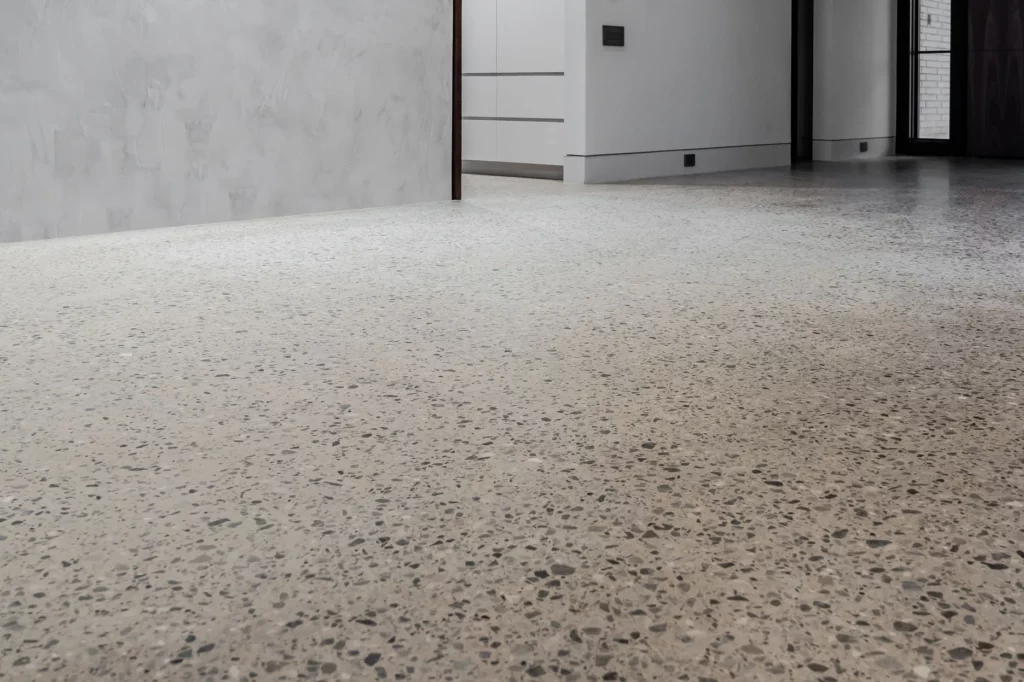
Carpet, Tile, or Wood Removal
If another type of flooring has been installed onto of the existing terrazzo, the first step of a terrazzo floor restoration project is the thoughtful demolition of the carpet, tile, or wood floor installed on top of the terrazzo floors. We use electric chipping hammers, angle grinders, and hand tools for this process. Incorrect removal can lead to additional damage to the terrazzo floor, so in most cases, this process should be left to an expert.
Previous tile, carpet, and wood flooring installations each bring different challenges during the repair and restoration process. For example, glue left by a wood flooring installation will stain and discolor the terrazzo and requires careful surface grinding to restore. Removing carpet tack strips will leave voids in terrazzo that we will fill with appropriate, matching terrazzo material.
Aggregate Pricing Overview
Marble Chips can range from $16-$40 per 50lb bag
Mother of Pearl is $80 – $100 per 50lb bag
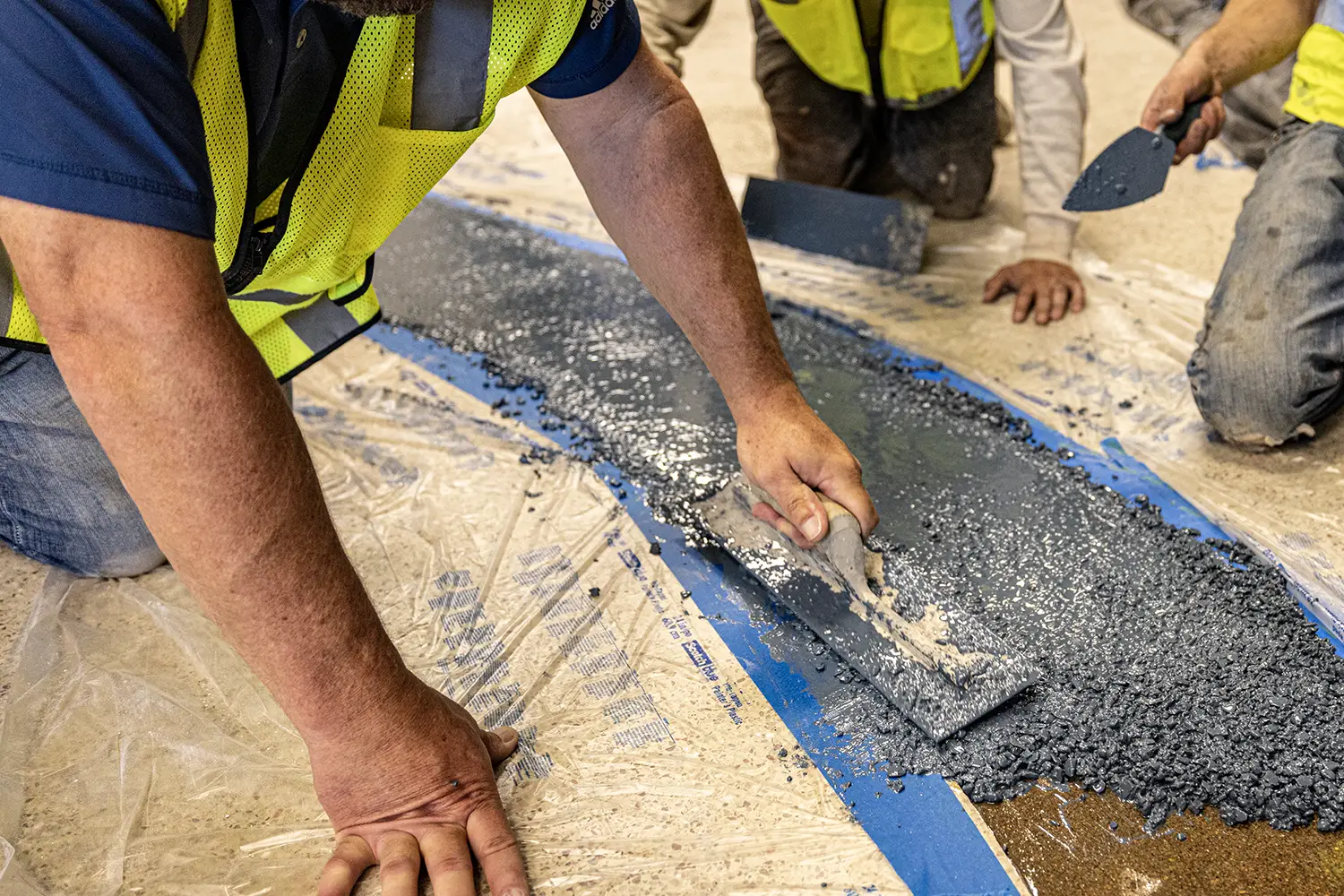
Terrazzo Floor Damage Repair
During the terrazzo restoration process, it’s reasonable to expect that your floor will require some repair. The most common repair is void filling. Void filling is required where the floor is damaged or gouged by heavy objects, or in situations where the floor-plan layout was modified, leaving an area without terrazzo where walls once were. These repairs are also common where floors were removed to access leaky plumbing.
For void repairs, we compare terrazzo aggregates with your existing floor using our extensive archive of marble chips. We remove a small piece of your floor and use it to computer-match the color of your terrazzo binder–in a process similar to buying paint at a big box retail construction store. This is process is an absolute necessity for properly restoring a terrazzo floor.
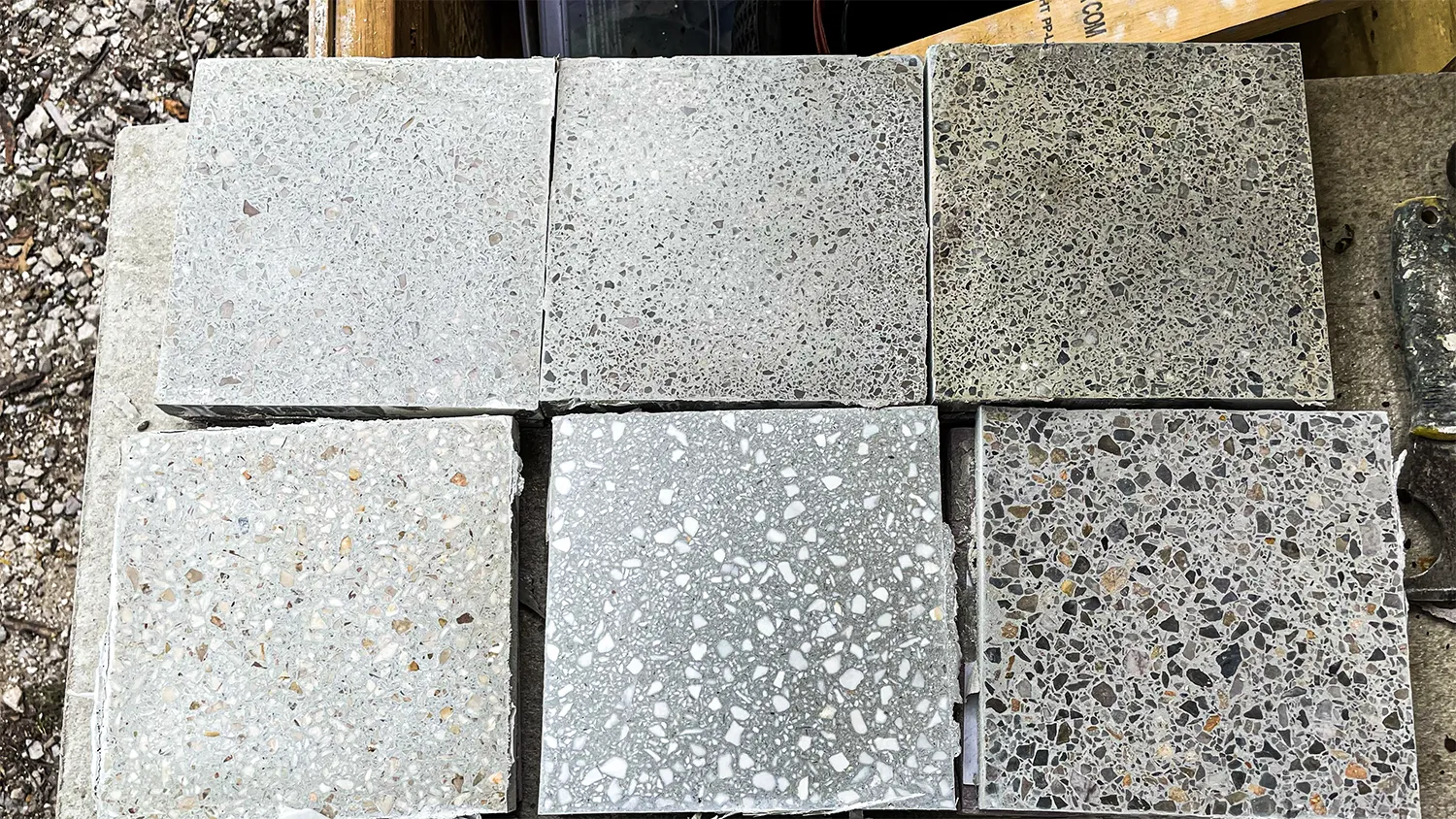
Terrazzo Samples for Restoration
After aggregates are selected and the epoxy binder is color-matched, we make samples to confirm that our selections perfectly match the existing terrazzo floors. Samples not only allow us to compare colors but also allow us to confirm that we have selected the correct rock sizes.
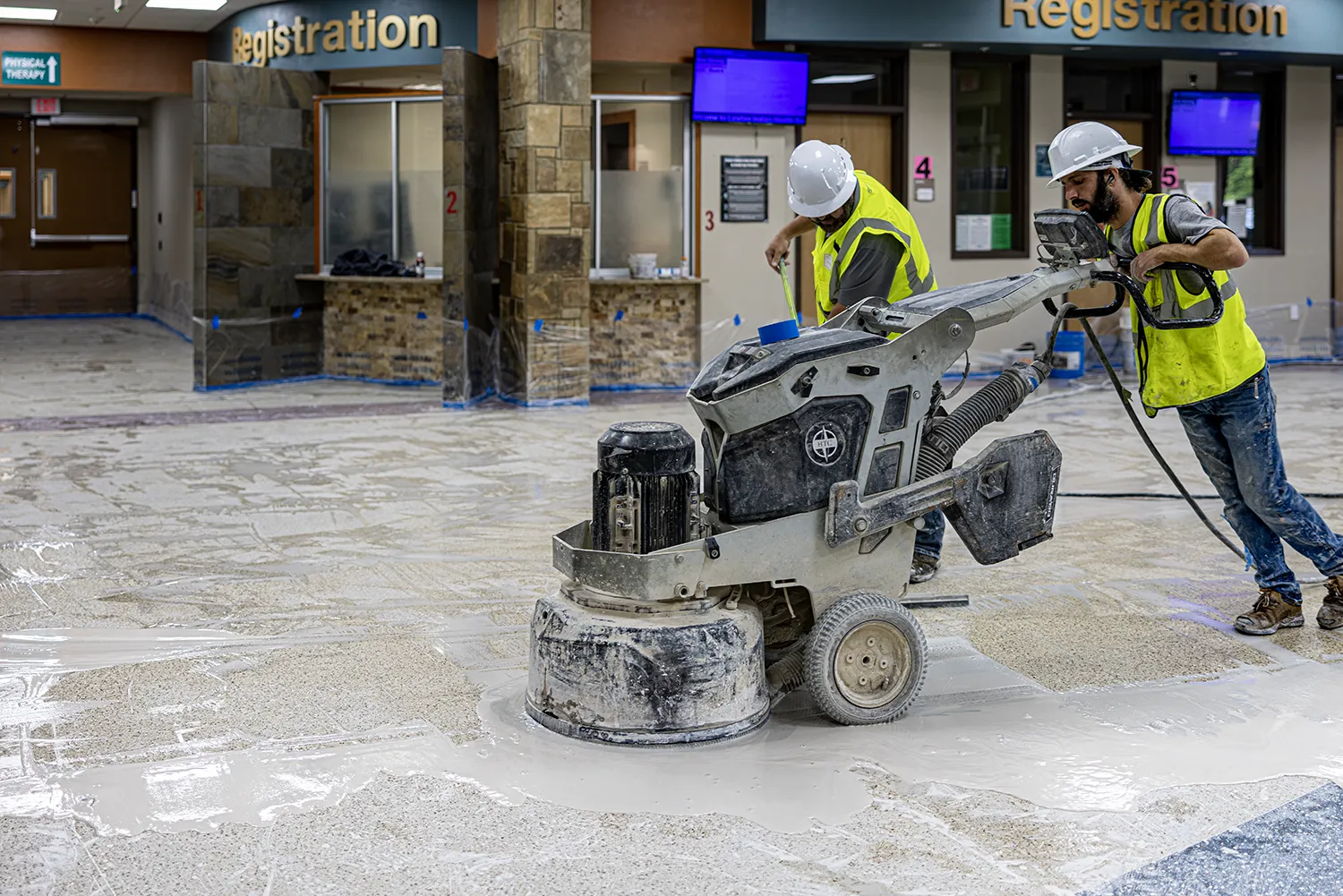
Waxing vs. Polishing
After repairing voids and cracks in your terrazzo flooring, the next step in your terrazzo restoration project is grinding it flat using an electric floor grinding machine. Aggressive diamond tools, typically 30 to 40 grit, are used in this process. This grinding process will remove any contamination from other flooring installations and level and blend any of the areas we filled during the damage repair phase of the terrazzo floor restoration process.
After grinding, the terrazzo floors must either be polished or waxed to achieve the final, reflective finish. Waxing, while a more traditional way to finish these floors, requires frequent stripping and waxing maintenance. Polishing is a more modern technique for finishing terrazzo floors and provides a more attractive appearance with lower long-term maintenance. Further, diamond-polished terrazzo floors are less prone to fine scratching from daily use than waxed or sealed terrazzo floors. Finally, polished terrazzo floors are less slippery than waxed floors, which may be beneficial for households with children or to reduce business slip and fall liability.
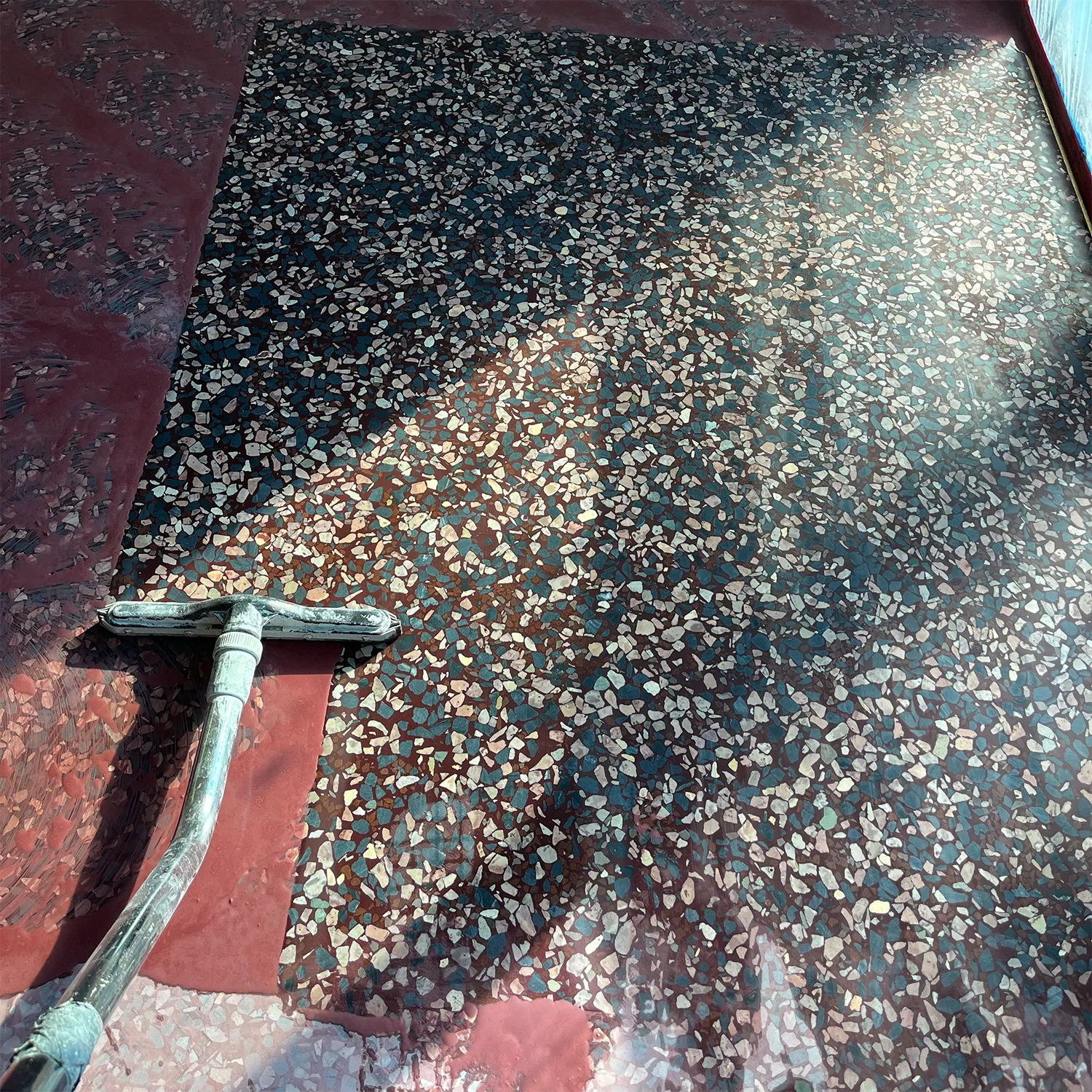
Terrazzo Restoration Cost
Terrazzo flooring costs are variable based on the square footage we restore and the amount of terrazzo repair work required.
Terrazzo Restoration Cost
Residential restoration jobs range from $7-12 per square foot
Repair work such as void filling is priced by the day with the addition of material cost
Commercial restoration jobs start as low as $5 per square foot, depending on the square footage.
Want to Learn More About Terrazzo Floors?
We’re here to guide you through the design of our products. A Concrete Floor Specialist will reach out within one business day.
Terrazzo Restoration Questions
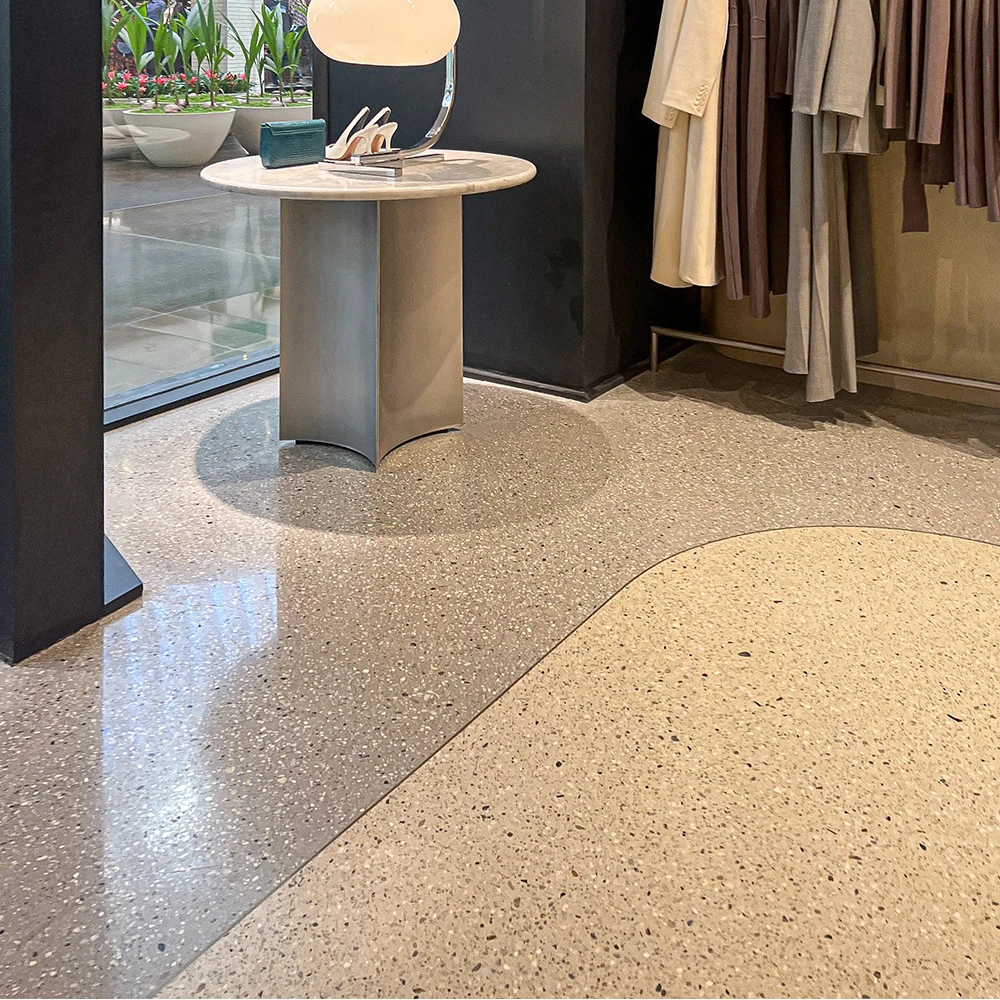
Are High gloss Terrazzo Floors Slippery?
Diamond-polished terrazzo floors offer a non-slip surface, easily meeting the OSHA standards for wet and dry slip resistance. Diamond-polished floors are incredibly flat and smooth, providing the maximum contact patch between a shoe or foot and the floor. In fact, we often install terrazzo floors because of their slip resistance to reduce slip and fall liabilities in commercial use cases. This is one of the main reasons why airports, stadiums, and schools utilize terrazzo flooring so frequently.
The confusion on this subject comes from the fact that waxed terrazzo floors are not slip-resistant. Wax is a soft acrylic coating applied to the terrazzo surface to increase gloss but acts as a contaminant on the floor’s surface. Because wax is soft, other contaminants, such as sand and dirt, get pushed into the surface, creating a textured surface that reduces the contact area between a foot and the floor. This is a recipe for disaster.
At Craftsman Concrete Floors, we always restore terrazzo floors correctly–with a heavy diamond grind and polish. This provides the most durable, slip-resistant terrazzo floor possible.
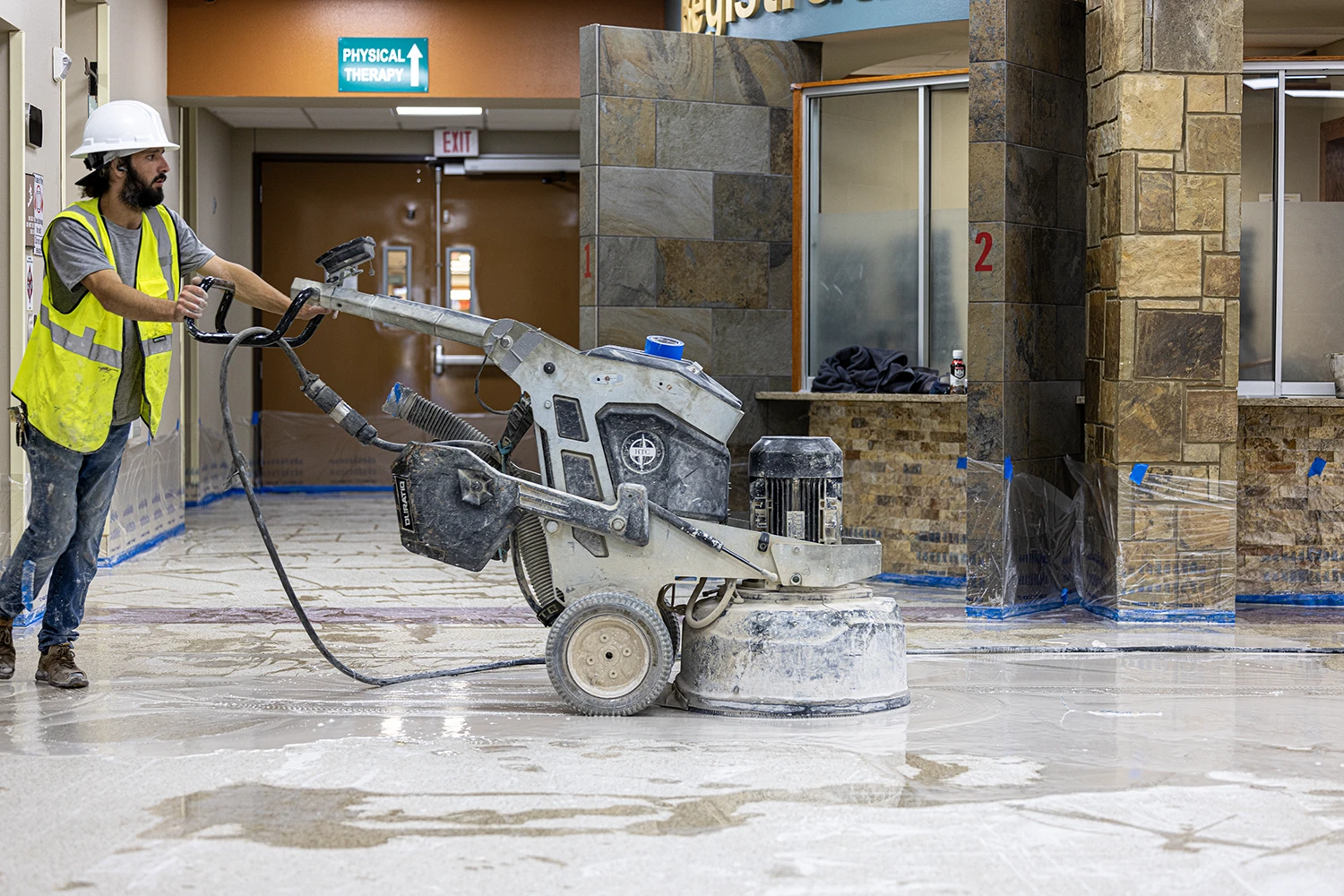
Can Terrazzo Floors be Buffed Instead of Polished?
Many companies use buffers to restore terrazzo floors. In this process, a chemical stripper removes contaminants, and progressively finer diamond buffing pads increase gloss. These systems are used to reduce equipment cost, but cannot provide an adequately restored floor.
The problem with these systems is that the weight and speed of a floor buffer are simply insufficient to hone a terrazzo floor properly. While restoration with a buffer can create a high gloss floor, it cannot create a properly polished floor that will offer longevity and durability to the project.
Craftsman Concrete Floors uses heavy mechanical grinders to hone terrazzo floors. While a floor buffer typically weighs around 80 pounds, our concrete grinders weigh more than 900 pounds. The additional pressure these grinders provide means we can adequately hone the floor, removing all surface scratching and creating a genuinely smooth, reflective, and durable surface.
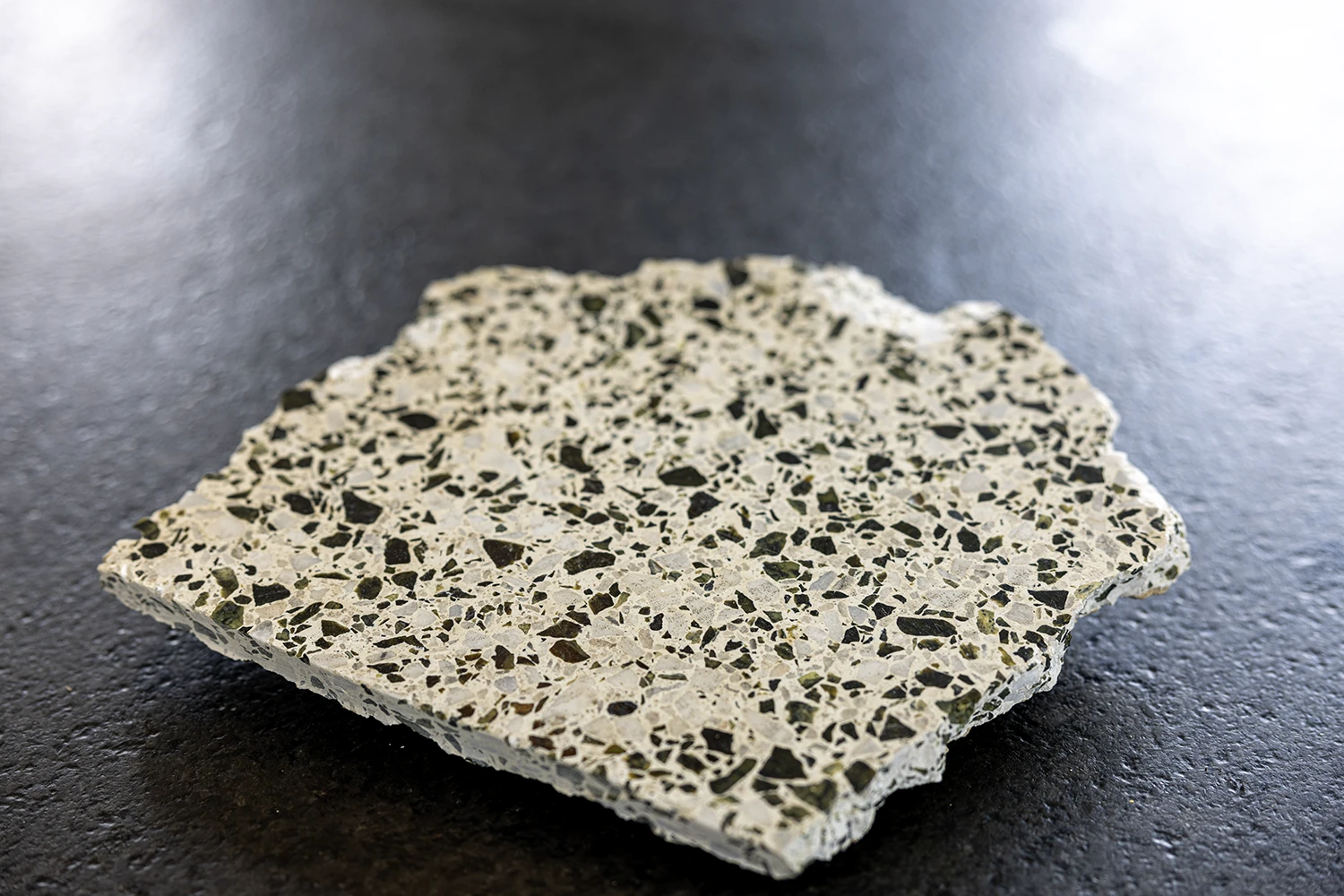
Do chips and holes have to be repaired?
On many restoration projects, we’re asked where it’s okay to leave minor chips and imperfections in a terrazzo floor. Unfortunately, it is not. As chips receive traffic, their edges degrade, creating larger chips. This degradation will eventually lead to structural issues in the terrazzo and costly repairs.
Some companies will repair surface imperfections by skimming the entire floor with an epoxy of a similar color, grinding the floor smooth, and then using permanent markers to draw rocks into the patch. This method is insufficient to create a good-looking, permanent repair.
At Craftsman Concrete Floors, we always do terrazzo repairs the old-fashioned way. First, we color-match the aggregates and binder, then make samples to confirm that we have a sufficient match. Next, we chip out the margins of the voids to create a vertical binding surface. Then each void is hand-filled and ground flat to create a seamless and permanent terrazzo repair that’s hardly visible.

How often do terrazzo floors need to be restored?
At Craftsman Concrete Floors, we recommend inspections every 3-5 years and repolishing every 7-10 years. Early maintenance is critical for terrazzo floors and will help reduce floor ownership costs. If your floors look different than they did when they were installed, it’s time for an inspection.
At Craftsman Concrete, we offer free consultations for terrazzo repair and maintenance projects. If you have a project that requires an inspection, give us a call for a free consultation.
Our Clients













Frequently Asked Questions about Terrazzo Floors
Polished terrazzo, the most common type used in flooring, provides excellent traction and is not slippery. However, waxed terrazzo may have a higher slip risk due to the added layer of wax. It’s important to exercise caution and maintain proper cleaning techniques to ensure safety.
Polished terrazzo is highly resistant to scratches and can withstand heavy foot traffic without losing its shine. However, waxed terrazzo is more susceptible to scratching, as the wax coating may be prone to scuffs and marks. Regular maintenance and proper care can help minimize the risk of scratches.
Yes, radiant heating can be added to terrazzo floors. The thermal conductivity of terrazzo makes it an excellent choice for radiant heating systems. This feature allows for efficient and comfortable heating, creating a cozy environment in your home during colder months.
We Restore Terrazzo Nationally, Including in:
Albuquerque, NM; Albany, NY; Anaheim, CA; Anchorage, AK; Arlington, TX; Arlington, VA; Atlanta, GA; Austin, TX; Bakersfield, CA; Baltimore, MD; Baton Rouge, LA; Birmingham, AL; Boise, ID; Boston, MA; Buffalo, NY; Chandler, AZ; Charleston, SC; Charlotte, NC; Chicago, IL; Chula Vista, CA; Cincinnati, OH; Cleveland, OH; Colorado Springs, CO; Columbus, OH; Corpus Christi, TX; Dallas, TX; Dallas-Fort Worth, TX; Denver, CO; Detroit, MI; Durham, NC; El Paso, TX; Fort Worth, TX; Fremont, CA; Fresno, CA; Garland, TX; Gilbert, AZ; Glendale, AZ; Grand Rapids, MI; Greensboro, NC; Hartford, CT; Hialeah, FL; Honolulu, HI; Houston, TX; Huntsville, AL; Indianapolis, IN; Irvine, CA; Jacksonville, FL; Jersey City, NJ; Kansas City, MO; Las Vegas, NV; Laredo, TX; Lexington, KY; Lincoln, NE; Long Beach, CA; Los Angeles, CA; Louisville, KY; Lubbock, TX; Madison, WI; Memphis, TN; Mesa, AZ; Miami, FL; Milwaukee, WI; Minneapolis, MN; Nashville, TN; New Orleans, LA; Newark, NJ; Norfolk, VA; North Las Vegas, NV; Oakland, CA; Oklahoma City, OK; Omaha, NE; Orlando, FL; Philadelphia, PA; Phoenix, AZ; Pittsburgh, PA; Plano, TX; Portland, OR; Providence, RI; Raleigh, NC; Reno, NV; Richmond, VA; Riverside, CA; Sacramento, CA; Salt Lake City, UT; San Antonio, TX; San Diego, CA; San Francisco, CA; San Jose, CA; Santa Ana, CA; Scottsdale, AZ; Seattle, WA; Spokane, WA; St. Louis, MO; Stockton, CA; Tampa, FL; Toledo, OH; Tucson, AZ; Tulsa, OK; Virginia Beach, VA; Washington, DC; Wichita, KS; Winston–Salem, NC
Blog
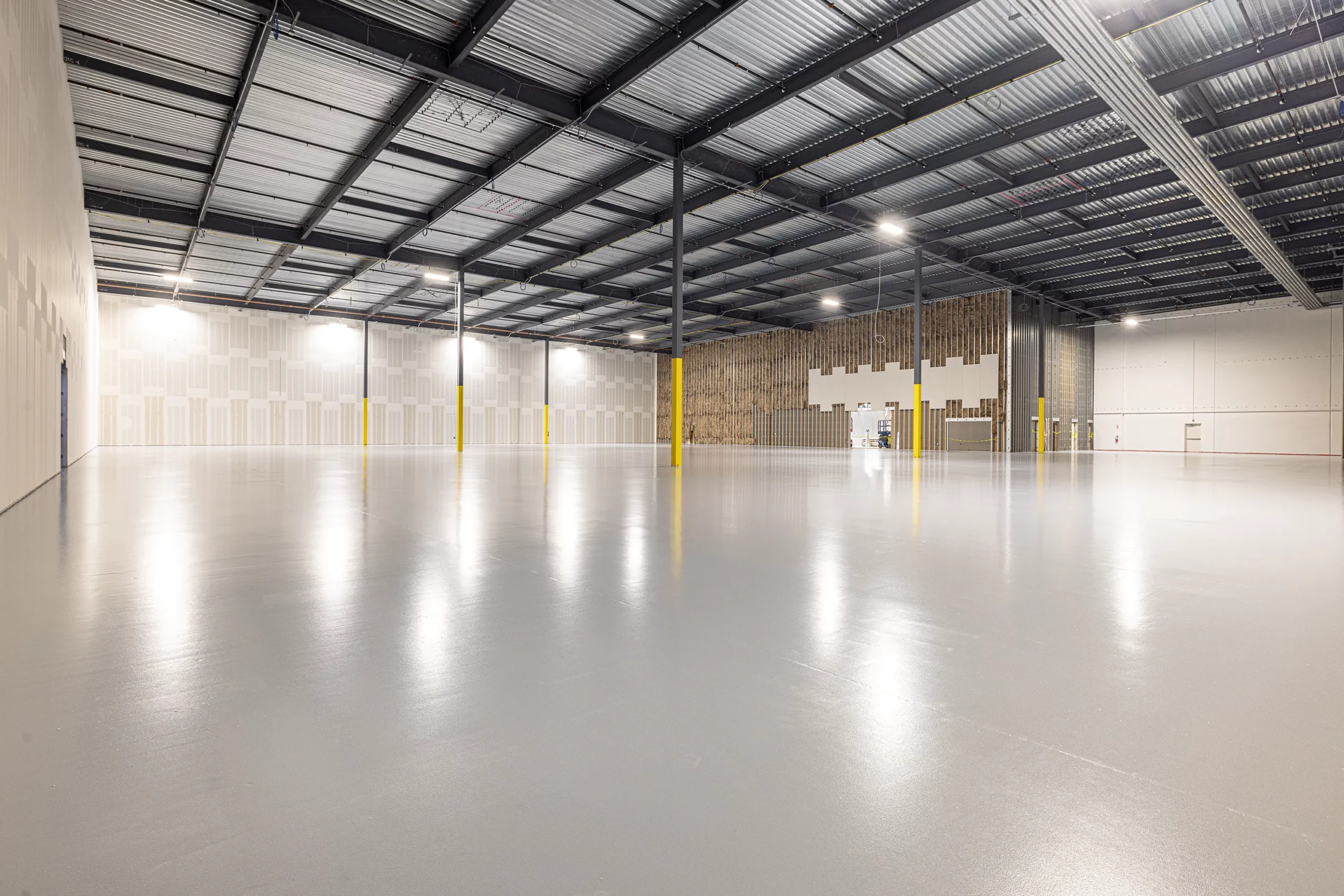
Project Highlight: 34,000 Sq. Ft. ESD Epoxy Installation in Dallas, Texas
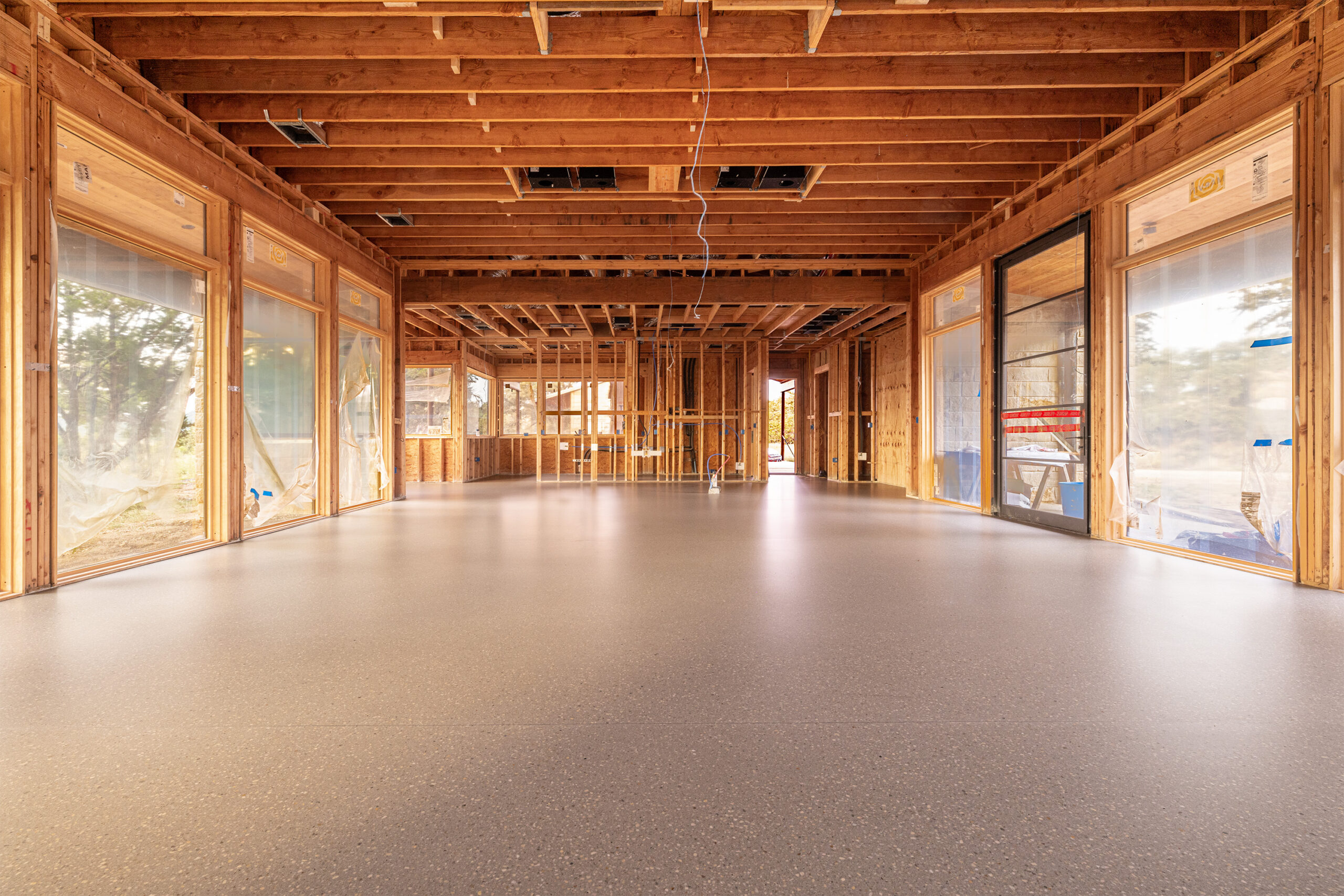
Project Highlight: New Residential Terrazzo Floors in Fort Worth, Texas
